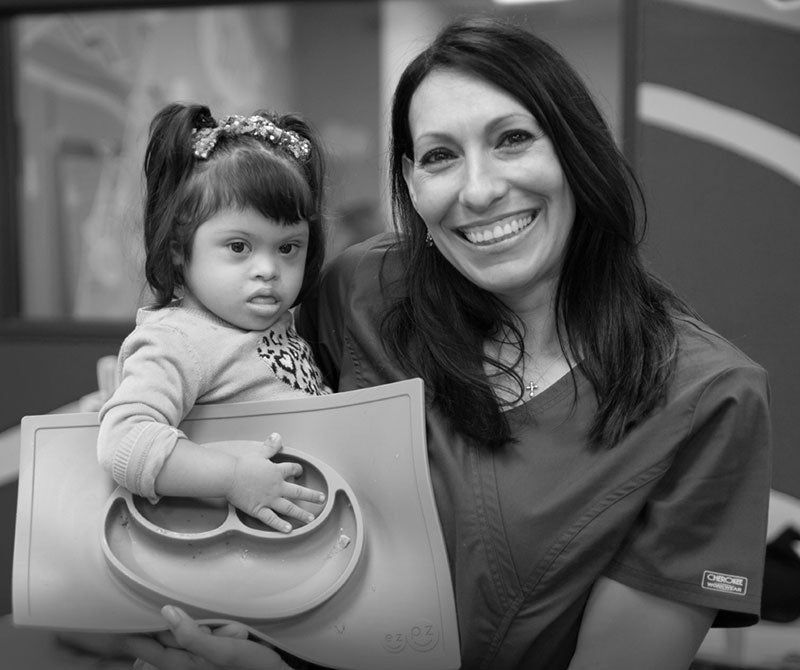Baby Led Weaning (BLW)
Tandem: As you begin this approach, it’s helpful to remember that the BLW method is less about removing breast / bottle-feeding from your baby’s diet, and more about adding complementary foods to your baby’s food repertoire. Thus, when educating parents about portion sizes, I often remind them that the American Academy of Pediatrics recommends breastfeeding for the first year of life. This gives parents a 6-month time period to continue to breastfeed as you introduce solids. To keep feeding expectations realistic, consider how much your child is nursing (and how full they might be) when you offer a portion of solid food.
Taste: Adding breast milk or formula to some of the solid food you are introducing to baby is a perfect way to blend familiar liquid tastes with new solid tastes and textures. Feeding your baby solid food is all about letting them experience a world of new tastes! It’s exciting to learn what flavors your baby enjoys and, then, you can combine these favorite tastes with other new fruits and vegetables. Focus on the fun moments of each explored taste rather than the amount of food your child is eating.
Tablespoons: Since your baby is still drinking breast milk or formula as their primary nutrition, slowly incorporate approximately 1-3 tablespoons of food for 1-2 meals a day. As your baby starts to eat more solids, the Mini Mat can help you keep track of portion sizes. Each ‘eye’ of the Mini Mat holds 2 ounces (4 tablespoons) and the ‘smile’ holds 4 ounces (8 tablespoons). Remember that some days your baby will eat more and other days a little less. Keep portion size approximations in mind, which will help keep stress low and make introducing solids fun for everyone!
Telltale Signs: Pay attention to the signs that your baby is full and allow them to control how much they explore and eventually eat. Some examples that your baby is full are: turning their head, pulling away, closing their mouth tightly, expressing disinterest, stopping you from putting more food on their plate or even handing food back to you! Continue to offer a variety of foods, tastes and textures, and allow your baby to make the decision about how much they will consume. This will strengthen the feeding relationship you have with your baby!
Trust: When you are breastfeeding or bottle-feeding, you establish a beautiful feeding connection grounded in trust. You make eye contact, you talk to your baby, you allow baby to eat until they are full and you are (usually) present in the moment. Sometimes, when parents start to feed baby solid foods, that trust relationship becomes damaged because parents are uncertain, likely due to unanswered questions or inaccurate information. This can result in force-feeding, over-feeding or under-feeding solid food. I work with parents that have been so frustrated with this process that they gave up on solids altogether (and came to me for help). Maintaining trust between you and baby will help your baby trust food! I promise, maintaining trust is more important than stressing about the exact amount of tablespoons the baby is consuming each day.
Learning the dance between breast / bottle-feeding and solids, focusing on tastes, using approximations with portion sizes, learning your baby’s cues and maintaining trust are the keys to success with BLW. Try to enjoy the learning curve of solid introduction and portion sizes with your little one. Get ready for some camera-ready mealtimes, because this milestone goes by fast!
Share your tips and BLW experiences with us! What helped you keep portion sizes realistic? #ezpzfun #blw
Happy Feeding!
Dawn Winkelmann, M.S, CCC-SLP
SPEECH LANGUAGE PATHOLOGIST & FEEDING SPECIALIST FOR EZPZ
Dawn Winkelmann, a.k.a “Ms. Dawn”, has treated thousands of kids across the globe by helping families overcome picky eating stages and food refusals, while adding new foods into their diet. Her high success rate is attributed to Ms. Dawn bringing her education, experience, sense of humor and her favorite feeding products to the family dinner table.
You will find Ms. Dawn’s expert feeding advice to be positive and fun for the entire family! She adapts complicated feeding/swallowing research and makes it practical and easy for parents! Get ready to learn the science behind your favorite feeding products and ways to bring happy family mealtimes back!



